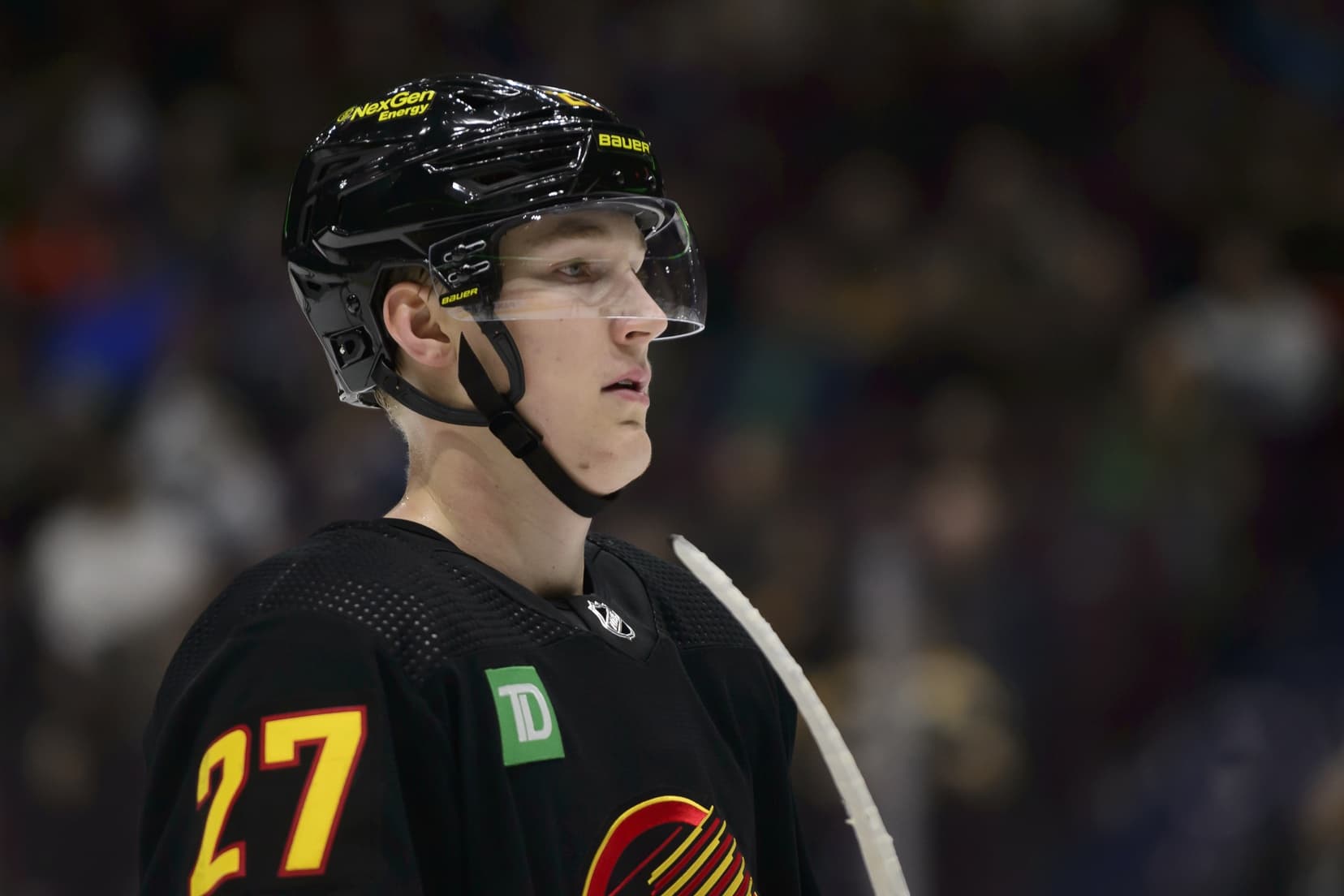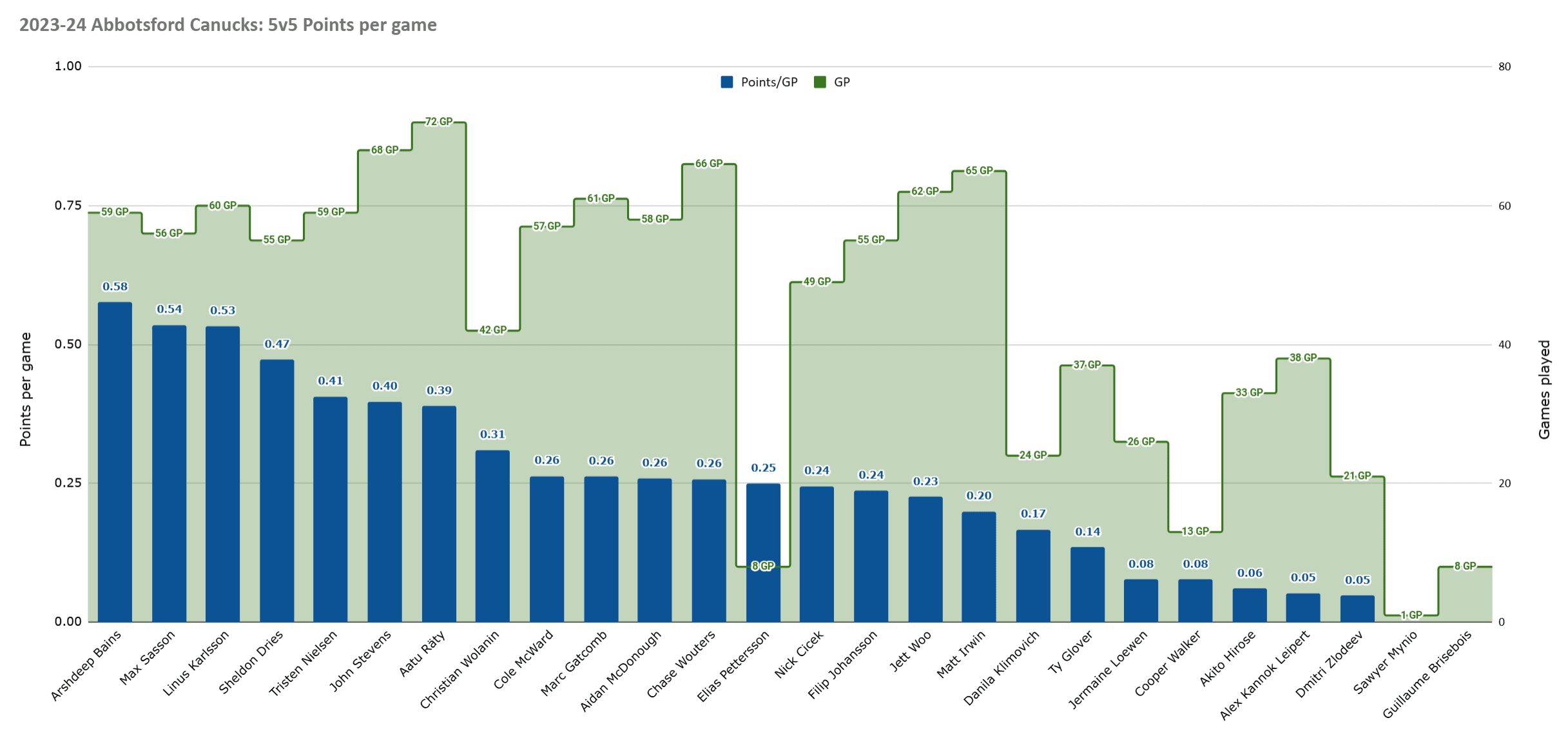Aatu Räty snipes his third goal in as many games. He's firing at a two-point pace over his last three games. #Canucks
Nation Sites
The Nation Network
CanucksArmy has no direct affiliation to the Vancouver Canucks, Canucks Sports & Entertainment, NHL, or NHLPA
Aatu Räty played everywhere for the Canucks, except in the NHL: Year in Review

Photo credit: © Anne-Marie Sorvin-USA TODAY Sports
Organizationally speaking, the 2023-24 season was nothing short of a success story for the Vancouver Canucks.
Whether it was Vancouver, Abbotsford, or prospects around the globe, success permeated throughout the entire system.
That includes Aatu Räty.
There were tons of positives to take away from the Finnish forward’s first full season with the organization since being acquired at the previous trade deadline.
The 21-year-old emerged as one of Abbotsford’s top producers, eclipsing career highs in every statistical category he last set during his Finnish U16 circuit days.
Playing in 72 games, the most by any Abbotsford skater, Räty racked up 18 goals and 52 points, tying Sheldon Dries with the third-most points on his squad. These numbers stood tall among his peers, finishing fifth among U22 skaters leaguewide.
While his career year was undoubtedly one to be encouraged by, statistically speaking, we believe there is still room for growth. After all, 18 of his points stemmed from the power play, and more than half of his 34 assists were secondary, leading the team with 19 total. Averaging 0.39 points per game at even strength, Räty finished seventh on the team behind players like Tristen Nielsen and John Stevens.

Chart courtesy of Cody Severtson of CanucksArmy.com
That’s not to say his season wasn’t a statistical success, just that his counting stats were more pedestrian-looking when diving deeper than his simple AHL.com ledger suggests.
Consistency was challenging. Throughout the season, Räty experienced dramatic hot and cold streaks. On any night, you weren’t confident in what version of Räty you could expect to see that evening.
You may recall, from the tail-end of the season, when he went on an incredible production run, recording 14 points across seven games. Yet, leading up to that blow-up, he had gone pointless in seven. Following that scorched earth run, he tallied just five points across his next 12 to close out the season.
This is to say that his season was positive, but there is still room for growth before he can be considered a bona fide top-end producer at the AHL level, let alone pencilled in as an NHL regular.
Still, he’s not far off.
Positive offensive developments
Beyond his counting stats, there were many solid takeaways from the offensive side of his season.
Typically known best for his vision and creativity, one standout element in his game was his release. Despite his reputation as a playmaker, Räty demonstrated a scoring touch, showing an impressive ability to beat netminders with a quick and heavy shot. As long as he had the time and space, he proved he could snap it with the best of them.
Although far from perfect, his skating also showed improvement. It may not meet top-six NHL standards just yet, but it was certainly a step up from what we saw in the previous season.
When he has the puck, he shows bursts of speed and the ability to beat defenders off the rush. However, his propensity to lower his stance into a wide base, coupled with his clunky stride when resetting, continues to limit his effectiveness as a forechecker. That constant juggling between low and high stances led to a noticeable drop in speed and performance, especially when his shifts ran long.
Versatile forward
One of the most impressive and positive signs of growth in his game was his versatility. He took on various roles within the team’s system as both a center and a winger (more on that later) at even strength, penalty kill, power play, at evens, when closing out games, and when trailing.
Quite literally, he played anywhere and everywhere for the Abbotsford Canucks this season.
Initially, Räty began the season as a third-line center, later finding a comfortable home on the wing, playing opposite Max Sasson and Linus Karlsson. While the trio’s tenure did not last all season long due to injuries and NHL promotions, their periodic reunions always brought offensive magic.
In addition to being one of the club’s go-to even-strength options, Räty played a key role on both special teams.
Although the team’s power play ranked an unflattering 23rd overall (17.6%), the AHL sophomore often found success on the half-wall, connecting with Linus Karlsson from below the goal line. While somewhat predictable, the set play below the goal line became one of the unit’s go-to threats.
Linus Karlsson collects the puck at the goal line and pulls the Abby #Canucks within one. Two points for Aatu Räty.
On the defensive end, he enjoyed successful stints on the league’s third-best penalty kill (85%). Being a mainstay of one of the league’s most successful penalty kills bodes well for his potential to crack the NHL lineup.
As they say, if you can’t stand out with pure skill, make sure that you can adapt your game. And boy, has he shown he can.
Centre or wing?
Ah yes, the million-dollar question: Can he play centre at the NHL level?
Räty has found most of his production success while playing the wings. Fortunately, a little position versatility never hurt anyone.
Already an established player in the face-off dot, Räty can be tasked with many situations, even if he’s slotted to play up the wing. As a natural centreman, he plays a credible two-way game and reads the play well in all three zones.
It really comes down to his skating, which throws a wrench into projecting his best fit.
While some manage to get away with skating inefficiencies by using various tools—physicality, lethal shooting, spin-o-rama zone entries, draft pedigree—the ability to play up the middle under “Rick Tocchet Hockey” begs the need for speed. Right now, there are reasonable doubts about whether his feet are up to par to play full-time minutes at the next level.
This is compounded by his ability, or lack thereof, to drive a line by himself. Throughout the year, you can pinpoint his successful stints, most of which can be directly linked to him playing on the wing. While admittedly an unexpected change for him, he took the assignment with ease and, for our money, commanded a much more offensive presence from that position.
The Malhotra effect
If there was one element that may counter that argument, it’s the hiring of Manny Malhotra, a longtime NHL veteran and noted defensive centre guru.
After moving on from Jeremy Colliton, it made sense for the Canucks to bring back a beloved ex-Canuck with a background in player development to take over as Abbotsford’s Head Coach.
Could Malholtra’s expertise as a face-off ace and defensive wiz be exactly what Räty needs to secure a role as a future NHL pivot? With Sheldon Dries now out of the picture, there will be a significant hole to fill in Abbotsford’s top six, and it isn’t unfair to expect Räty to fill it.
With a depleted depth chart up the middle, it is in the organization’s best interest that Räty excels in his tenured position. The 2024-25 season will be massive for his development, determining his long-term fit in the organization.
What’s next?
As one of the depth chart’s top prospects, there is certainly a path toward Aatu Räty earning an NHL spot out of training camp.
Yet, the more likely path is one more year on the farm to continue refining the necessary tools to help him take that next step. If he can offer a repeat season, especially if he is driving a line on his own, don’t be shocked to see him playing NHL games at some point next year. Even if those games come with him on the wing.
Breaking News
- ‘Key part of our rebuild’: Canucks’ Rutherford and Allvin address the Quinn Hughes trade
- Canucks trade captain Quinn Hughes to Minnesota Wild; Marco Rossi and more headed to Vancouver
- Canucks played to smallest home crowd of season so far in Thursday’s loss to Sabres
- ‘This is different’: Boeser shares frustrations after Canucks’ losing homestand
- How being at the top of the waiver charts could help the Canucks as they try to close trades
